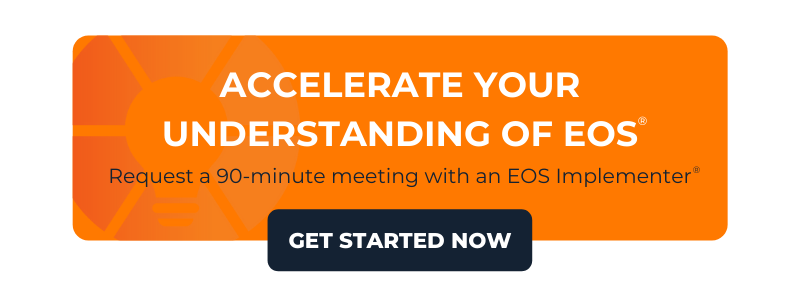
Which scenario would you prefer – being handed a series of goals you don’t fully understand and didn’t provide any input for, or working together as a team to develop the best possible goals for your organization? How long would you remain an employee under the first scenario?
As leadership expert Ken Blanchard teaches, leadership is working with people to accomplish their roles and the goals of the organization. By including your team in the planning process, you can create a culture that oozes trust, excitement and ownership, and ultimately makes your job as a leader easier.
HOW TO START PLANNING WITH YOUR TEAM
You’d be amazed how much knowledge can be gained by asking your team questions! Through their time with you and elsewhere in their careers, they’ve gathered insights you may not have even considered. Here are a few key questions to get you started:
1. WHAT ARE WE TRYING TO ACHIEVE?
Sometimes it’s what you see as the greater end-goal, or maybe you’re gathering the goals of your customers, the members of your organization, a board, or even an executive team. It could be a number (i.e. revenue, or an increased number of clients), a list of things that your team needs to complete, or it could be a plan to start down an entirely new path.
Your goals can be anything, but they must be completely clear to the people tasked with achieving them.
2. WHAT IS THE CURRENT STATE?
In his book Good to Great, Jim Collins introduced us to the term “brutal facts” in what he called the Stockdale Paradox:
“Every good-to-great company faced significant adversity along the way to greatness… In every case, the management team responded with a powerful psychological duality. On the one hand, they stoically accepted the brutal facts of reality. On the other hand, they maintained an unwavering faith in the endgame, and a commitment to prevail as a great company despite the brutal facts. We came to call this duality the Stockdale Paradox.”
Once the target we are trying to achieve is clear, we must honestly assess our current performance, the capacity of our team, and the capability of our product or service. Understanding, in the clearest and most honest terms, where we currently stand allows us to truly see what must change for us to achieve our goal.
3. WHAT ARE THE KEY STEPS/WORK THAT WE MUST COMPLETE TO ACHIEVE THE TARGET?
The answer to this question creates our roadmap and should be SMART (Specific, Measurable, Achievable, Results-oriented, and Time-bound). Once you’ve established the key steps that will help your team achieve their goal, you must decide on a specific person that will take ownership of each step’s completion.
By establishing a sole owner for each task, you greatly increase the chances that they’ll complete the work and provide frequent, honest updates to the team on their progress or areas where they may need help.
4. WHAT KEY QUESTIONS NEED TO BE ANSWERED FOR 90% CERTAINTY THAT WE WILL ACHIEVE THIS GOAL?
One of the characters from the Winnie the Pooh stories, Eeyore, is famous for his eternally pessimistic outlook and brutal honesty. While this approach often dampened the moods of the other characters, it also brought a clear perspective.
Every plan has to invite this level of pessimism to understand which barriers or risks we need to address. Maybe 90% isn’t the right number for your organization, so pick a number that reflects the team’s risk tolerance. Ultimately it will drive you to either think bigger or abandon a goal that has no ROI for your business.
Finally, remember that a “planning” session is not a “telling” session. Each member of your team brings valuable insights that should be considered at the start of the planning process, not after you’ve given it hours of thought and decided on a strategy on your own.
BUILDING A FOUNDATION OF TRUST
Involving your team in planning isn’t just another leadership exercise, it’s a powerful trust-builder too.
In his 2017 Harvard Business Review Article, “The Neuroscience of Trust,” Paul J. Zak explains his research around management behaviors that genuinely impact employee engagement. His research showed that employees in high-trust organizations are more productive, have more energy at work, collaborate better with their colleagues, and stay with their employers longer.
The article goes on to identify 8 management behaviors measured to increase trust in people. The top 3 might surprise you:
- Recognize excellence.
- Induce “challenge stress.”
- Give people discretion in how they do their work.
Can you see how planning and the discipline to follow the plan to completion hits all three of these? Planning provides a great tool to lead, and if you are not doing it with your team I challenge you to start at the earliest opportunity.
As an EOS Implementer®, I work with 20+ leadership teams each year, and improved employee retention is a core goal in almost every plan. In my experience, this all starts with trust, both leaders trusting their teams and teams trusting their leaders. Use your next planning session to start building trust with your teams, and confidently head into the new year with your plan in hand!
Interested in learning more leadership practices? Download a [free chapter of How to Be a Great Boss](https://www.eosworldwide.com/great-boss-book) by Gino Wickman and René Boer to learn how to be a more effective leader and manager.
Originally posted on 1/5/22 at [Your Secret Resource for Company Planning – Your Team](https://www.eosworldwide.com/implementer-posts/if-you-arent-planning-you-arent-leading-4-starting-questions)






